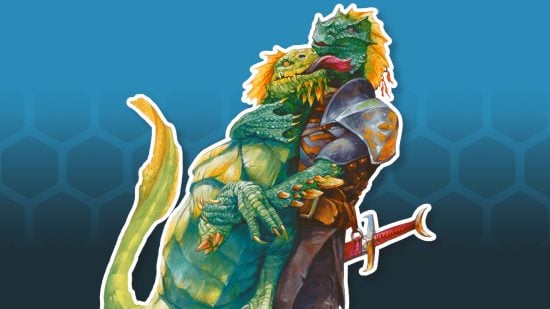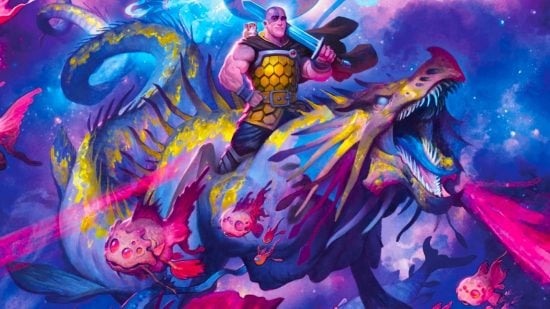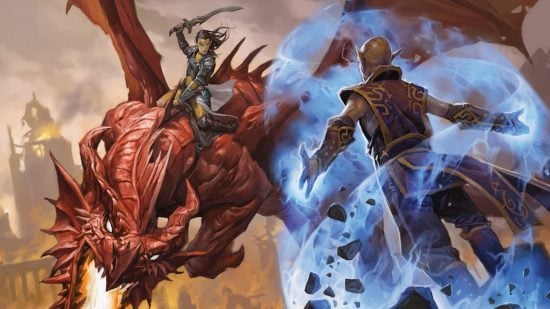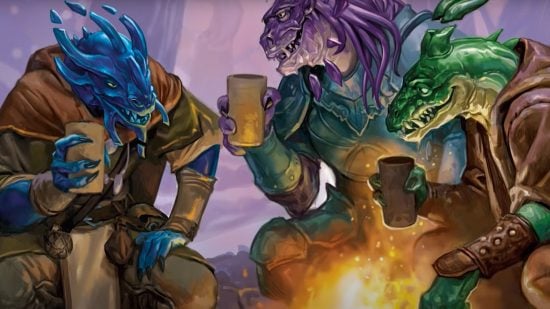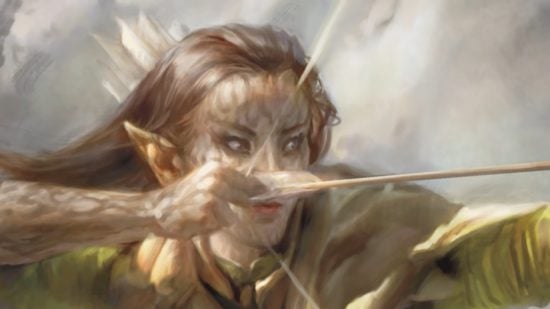While other Rangers were communing with the flora and fauna of the forest, the DnD Drakewarden had other ambitions. This Ranger has built a special bond with a drake, who fights by their side in battle and grows bigger and stronger the more their Ranger cares for them. If a dragon companion appeals, you should take a look at the Drakewarden 5e subclass.
If you haven’t picked up your DnD books in a while, don’t worry – we cover everything about this DnD Ranger subclass in this handy DnD classes guide. As well as the Drakewarden’s core features, we’ll recommend the best DnD races and 5e feats to add to your DnD character build.
Here’s everything you need to know about the DnD Drakewarden 5e:
- Drakewarden 5e features
- Best races for Drakewarden 5e
- Best feats for Drakewarden 5e
Drakewarden 5e features
Here’s what each DnD level up brings for the Drakewarden:
Draconic Gift
Level: Three
Your link with the dragon world (as well as your literal drake companion) offers you two initial benefits. Firstly, you can cast Thaumaturgy 5e as a Ranger cantrip. And secondly, you can speak Draconic, plus any other DnD language of your choice.
Drake Companion
Speaking of that drake companion, this is the action you’ll use to summon them. The drake always appears in an unoccupied space within 30 feet, and it can have any physical appearance you want.
As part of the summoning, you’ll choose an element (acid, cold, fire, lightning, or poison). The drake companion will be immune to this DnD damage type for the duration of the summon, and they’ll deal this kind of damage with their Infused Strike feature (see stat block below).
In combat, your drake shares your initiative count, acting immediately after your turn. You can spend a bonus action to command your drake, and it can perform any action listed in its stat block. If you don’t direct the drake, it’ll take the Dodge action every turn, but it can move and use reactions independently.
Now you’ve summoned a new best friend, they’ll stick with you until the end. Mechanically, that means your drake buddy hangs around until they reach zero hit points, you die, or you summon a new drake by performing the Drake Companion action again. You can only summon a drake once per long rest 5e – unless you spend a spell slot of first level or higher.
Drake Companion stat block
| Size | Small |
| Armor class | 14 + your proficiency bonus |
| Hit points | 5 + five times your Ranger level |
| Hit dice | Equal to your Ranger level |
| Speed | 40ft |
| Strength | 16 (+3) |
| Dexterity | 12 (+1) |
| Constitution | 15 (+2) |
| Intelligence | 8 (-1) |
| Wisdom | 14 (+2) |
| Charisma | 8 (-2) |
| Saving throws | Dexterity (1 + proficiency bonus), Wisdom (2 + proficiency bonus) |
| Senses | Darkvision (60ft), passive Perception (12) |
| Languages | Draconic |
The drake companion has the following features:
- Draconic Essence – When summoned, the drake’s creator chooses a damage type from acid, cold, fire, lightning, or poison. The drake is immune to this type of damage, and it deals that damage type with Infused Strikes.
- Bite – As an action, the drake makes a melee weapon attack (+3 + your proficiency bonus to hit, reach five feet, one target). On a hit, it deals 1d6 + your proficiency bonus in piercing damage.
- Infused Strikes – When another creature the drake can see within 30 feet hits a target with a weapon attack, the drake can spend a reaction to add 1d6 extra damage to the attack. The damage type is determined by its Draconic Essence.
Bond of Fang and Scale
Level: Seven
From level seven, the drakes you summon have wings and a flying speed equal to their walking speed. Additionally, the drake goes up a DnD size to Medium. You can now use it as a mount as long as your Ranger is Medium or smaller. However, the drake is unable to fly while used as a mount.
Your scaly bestie also becomes more combat-proficient at level seven. The drake’s bite now deals an extra 1d6 damage – with the damage type determined by Draconic Essence. And, because best friends protect each other, you now become resistant to the chosen Draconic Essence damage type.
Drake’s Breath
Level: 11
As an action, you or your drake can breathe out a 30-foot cone of damaging breath. The damage type can be acid, cold, fire, lighting, or poison damage – and it doesn’t have to match your Draconic Essence choice.
Every creature you hit makes a Dexterity saving throw. They take 8d6 damage on a failed save and half as much on a success. The damage goes up to 10d6 once you reach level 15.
Unless you’re prepared to fork out a level three (or higher) spell slot, you can only use this feature once per long rest. But given that this is basically the DnD Dragonborn’s breath on steroids, it’s worth the wait.
Perfected Bond
Level: 15
Your drake gets another major buff. Its bite deals an extra 1d6 damage of the Draconic Essence type chosen – that’s now 2d6 extra damage aggregate. The drake also grows to the Large size, and it can fly even when used as a mount.
Finally, you gain a new reaction to protect your most cherished friendship. If you or the drake take damage while within 30 feet of each other, you can use Reflexive Resistance to give you or the drake resistance to the incoming damage type. This can be used a number of times equal to your proficiency bonus, with all uses replenished on a long rest.
Best races for Drakewarden 5e
If you’ve only got the Player’s Handbook to work with, we’d recommend choosing the Wood Elf 5e for your Drakewarden. This boosts your Dexterity and Wisdom, offers some extra weapon proficiencies, and increases your speed by five feet. Overall, it’s a solid choice for any nimble Ranger.
The Variant DnD Human also makes an excellent choice for any character build. Any race can have customizable DnD stats thanks to Tasha’s Cauldron of Everything, but a free feat at level one is nothing to be sniffed at.
For a more thematic choice, there’s always the Dragonborn. You’ll need to use Tasha’s custom origin rules if you want to have any relevant stat boosts, of course, and there’s no mechanical benefit to choosing this race. But a dragon person who can summon other tiny dragons? Exquisite.
Speaking of dragons, the DnD Kobold is equally thematic and offers mechanical benefits. An extra cantrip and a bonus action that gives allies advantage on attack rolls come in handy – just be sure to position your drake and Drakewarden carefully on the battlefield.
Best feats for Drakewarden 5e
Many Drakewarden builds focus on ranged combat, and if you’re following the trend, Sharpshooter is a must-have feat for the Drakewarden. No disadvantage at close range, and the ability to deal an extra ten damage in exchange for an attack roll penalty? Yes please.
Generally, 5e feats that boost your most important stat (Dexterity) are helpful too. If you choose to play an Elf, Elven Accuracy buffs your Dex and lets you reroll the occasional attack. Resilient also gives you proficiency in saving throws for the stat of your choice, and Skill Expert expands your DnD skills list to make you more useful outside of combat.
For more Ranger options, here are the best DnD Ranger subclasses ranked. And, to continue building your Drakewarden, check out the DnD backgrounds and 5e spells you can choose from.
